Hven, 1576-97: Tycho Brahe's observatory
Commentary
Image 1. Tycho Brahe, Astronomiæ instauratæ mechanica.(Wandesburgi, 1598), fol. 41v: 'Design of the main building of Uraniborg'
Image 2: Uraniborg reimagined by Hven Heinrich Hansen in an oil painting of 1882. Photo: Danish National Historical Museum at Frederiksborg Castle: An image of Uraniborg produced with 3D modelling software is available here.
Commentary. The most famous piece of 'big science' infrastructure created in the sixteenth-century in unquestionably Uraniborg, the astronomical observatory and alchemical laboratory erected by Tycho Brahe at royal expense on the Danish island of Hven. Uraniborg is also renowned as the site of the most sustained, the most precise, and the most successful programme of astronomical observation of the pre-telescopic era. As such, it provides a natural starting point for considerations of the ways in which princely patronage shaped scientific investigation in our period.
Tycho's Astronomiae instauratae mechanica, in which this description is found, can be divided into three main sections (each treated in its own cluster within Cabinet), of which the third only is prescribed.:
- Preliminary material includes the title page, inscriptions on the Bodleian copy, dedication to Rudolf II and verses to Tycho. Those texts which have been translated should be studied for interest, but are not transcribed.
- Description of instruments makes up the body of the work, treating the astronomical instruments constructed by Tycho in Uraniborg. A hyperlinked list of these instruments can be found here. here translations are provided as an aid to further study, but these texts are not prescribed.
- Uraniborg includes his description of his astronomical laboratory and other concluding material. This alone is the prescribed reading: folios 40r to 43rv
Related resources
Tycho Brahe: prosopographical data and biographical sketch at the Galileo Project, Rice University.
Astronomiæ instauratæ mechanica: Digital facsimile with English translation. Another beautifully hand-coloured copy in the Royal Library in Copenhagen is available online, together with the English translation of most of the work provided by Hans Ræder, Elis Strömgren and Bengt Strömgren, ed. and trans, Tycho Brahe's description of his instruments and scientific work: as given in Astronomiae instauratae mechanica (Wandesburgi 1598) (Copenhagen, 1946).
Astronomical systems: excellent brief videos from the Museo Galileo in Florence demonstrating the Ptolemaic, Copernican and Tychonic systems. Also relevant are the videos on Pretelescopic astronomy and epicyclical theory.
The Noble Dane: Images of Tycho Brahe: a virtual exhibition at the Museum of the History of Science, which also treats of his relationship with Rudolf II.
The Correspondence of Tycho Brahe: a digital catalogue by Adam Mosley, Early Modern Letters Online,
The Tycho Brahe Museum: website, located in Sweden because the island of Hven/Ven has passed into Swedish possession.
UNESCO Portal of the Heritage of Astronomy includes further images and text describing Uraniborg and Stellaeburgum and a useful bibliography.
Secondary literature
Christianson, J.B. On Tycho´s Island: Tycho Brahe and His Assistants 1570-1601. Cambridge: Cambridge University Press, 2008.
Mosley, A. Bearing the Heavens: Tycho Brahe and the Astronomical Community of the Late Sixteenth Century. Cambridge: Cambridge University Press, 2007.
Thorén, V. The Lord of Uraniborg: A Biography of Tycho Brahe. Cambridge: Cambridge University Press, 2006.
Wolfschmidt, Gudrun. 'The Observatories and Instruments of Tycho Brahe.' In: Tycho Brahe and Prague: Crossroads of European Science. Proceedings of the International Symposium on the History of Science in the Rudolphine Period; Prague, 22-25 October 2001. Ed. Christianson, John Robert; Hadravová, Alena; Hadrava, Petr and Martin Šolc. Frankfurt am Main: Harri Deutsch (Acta Historica Astronomiae Vol. 16) 2002, pp. 203-16.


